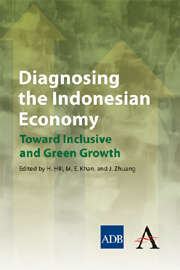Book contents
- Frontmatter
- Foreword
- Preface
- Author Profiles
- Abbreviations and Acronyms
- Contents
- 1 Introduction
- 2 Development Policies and Performance
- 3 Critical Constraints to Growth
- 4 Critical Constraints to Reducing Poverty and Inequality
- 5 Macroeconomic Management
- 6 Industrialization: Patterns, Issues, and Constraints
- 7 Infrastructure Development: Challenges and the Way Forward
- 8 Human Capital and Economic Development
- 9 Economic Growth, Employment Creation, and Poverty Alleviation
- 10 Poverty Reduction: The Track Record and Way Forward
- 11 Decentralization
- 12 Making Indonesia's Growth Green and Resilient
- Index
12 - Making Indonesia's Growth Green and Resilient
Published online by Cambridge University Press: 05 May 2012
- Frontmatter
- Foreword
- Preface
- Author Profiles
- Abbreviations and Acronyms
- Contents
- 1 Introduction
- 2 Development Policies and Performance
- 3 Critical Constraints to Growth
- 4 Critical Constraints to Reducing Poverty and Inequality
- 5 Macroeconomic Management
- 6 Industrialization: Patterns, Issues, and Constraints
- 7 Infrastructure Development: Challenges and the Way Forward
- 8 Human Capital and Economic Development
- 9 Economic Growth, Employment Creation, and Poverty Alleviation
- 10 Poverty Reduction: The Track Record and Way Forward
- 11 Decentralization
- 12 Making Indonesia's Growth Green and Resilient
- Index
Summary
Introduction
The current climate, food, fuel, and water crises have convinced many countries, including Indonesia, that a diff erent model of economic growth is needed. “Green growth”—a growth path that places longterm developmental and environmental sustainability at its core—has emerged as a desirable paradigm in Indonesia, and the concept of a low carbon, green economy has moved into the mainstream of the country's policy discourse over the recent years. Indonesia's green growth strategy rightly recognizes that the country's sustainability depends not only on the pace of physical and human capital accumulation, but also on its natural capital.
However, transforming the growth trajectory to one that is green, resilient, and sustainable is by no means an easy task. This is because of the multiple and simultaneous challenges of dealing with unavoidable and uncertain climate risks; attaining energy security; improving access to energy; managing scarce resources, particularly forests, land, and water; and finding ways to reduce greenhouse gas (GHG) emissions while creating new economic opportunities and minimizing adverse social consequences. A number of barriers stand in the way of achieving these goals.
As in other developing countries, natural capital is a significant share of total wealth in Indonesia, greater than the share of physical capital (World Bank 2006b). Green growth is therefore essential for Indonesia's longterm sustainability. Broadly, environmentally unsustainable growth may be attributed to two sources: (1) global environmental risks, particularly associated with the impacts of climate change; and (2) the degradation of environmental and natural resources that occurs locally (Figure 12.1).
- Type
- Chapter
- Information
- Diagnosing the Indonesian EconomyToward Inclusive and Green Growth, pp. 429 - 466Publisher: Anthem PressPrint publication year: 2012



